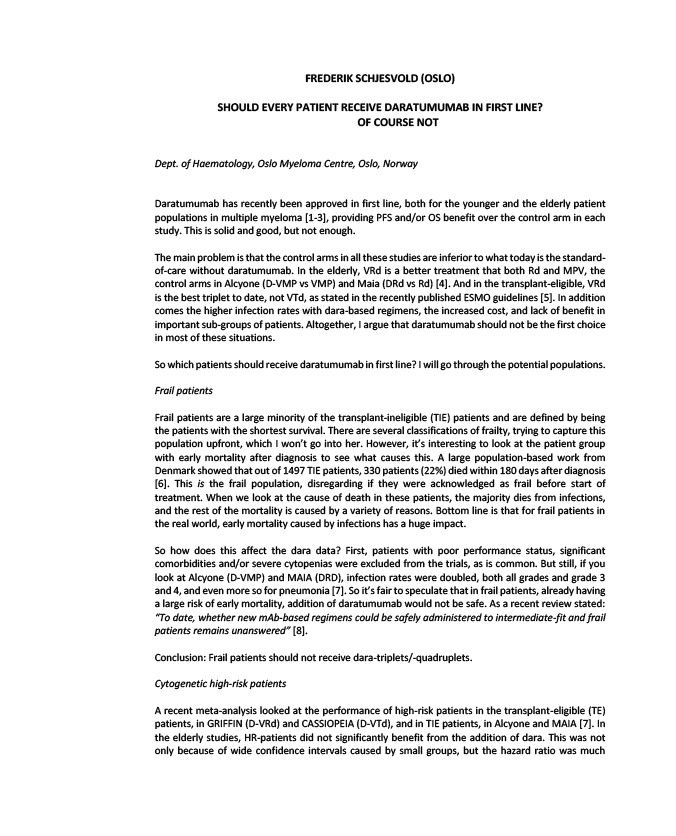
FREDERIK SCHJESVOLD (OSLO)
SHOULD EVERY PATIENT RECEIVE DARATUMUMAB IN FIRST LINE?
OF COURSE NOT
Dept. of Haematology, Oslo Myeloma Centre, Oslo, Norway
Daratumumab has recently been approved in first line, both for the younger and the elderly patient
populations in multiple myeloma 1-3, providing PFS and/or OS benefit over the control arm in each
study. This is solid and good, but not enough.
The main problem is that the control arms in all these studies are inferior to what today is the standard-of-
care without daratumumab. In the elderly, VRd is a better treatment that both Rd and MPV, the
control arms in Alcyone (D-VMP vs VMP) and Maia (DRd vs Rd) 4. And in the transplant-eligible, VRd
is the best triplet to date, not VTd, as stated in the recently published ESMO guidelines 5. In addition
comes the higher infection rates with dara-based regimens, the increased cost, and lack of benefit in
important sub-groups of patients. Altogether, I argue that daratumumab should not be the first choice
in most of these situations.
So which patients should receive daratumumab in first line? I will go through the potential populations.
Frail patients
Frail patients are a large minority of the transplant-ineligible (TIE) patients and are defined by being
the patients with the shortest survival. There are several classifications of frailty, trying to capture this
population upfront, which I won’t go into her. However, it’s interesting to look at the patient group
with early mortality after diagnosis to see what causes this. A large population-based work from
Denmark showed that out of 1497 TIE patients, 330 patients (22%) died within 180 days after diagnosis
6. This is the frail population, disregarding if they were acknowledged as frail before start of
treatment. When we look at the cause of death in these patients, the majority dies from infections,
and the rest of the mortality is caused by a variety of reasons. Bottom line is that for frail patients in
the real world, early mortality caused by infections has a huge impact.
So how does this affect the dara data? First, patients with poor performance status, significant
comorbidities and/or severe cytopenias were excluded from the trials, as is common. But still, if you
look at Alcyone (D-VMP) and MAIA (DRD), infection rates were doubled, both all grades and grade 3
and 4, and even more so for pneumonia 7. So it’s fair to speculate that in frail patients, already having
a large risk of early mortality, addition of daratumumab would not be safe. As a recent review stated:
“To date, whether new mAb-based regimens could be safely administered to intermediate-fit and frail
patients remains unanswered” 8.
Conclusion: Frail patients should not receive dara-triplets/-quadruplets.
Cytogenetic high-risk patients
A recent meta-analysis looked at the performance of high-risk patients in the transplant-eligible (TE)
patients, in GRIFFIN (D-VRd) and CASSIOPEIA (D-VTd), and in TIE patients, in Alcyone and MAIA 7. In
the elderly studies, HR-patients did not significantly benefit from the addition of dara. This was not
only because of wide confidence intervals caused by small groups, but the hazard ratio was much